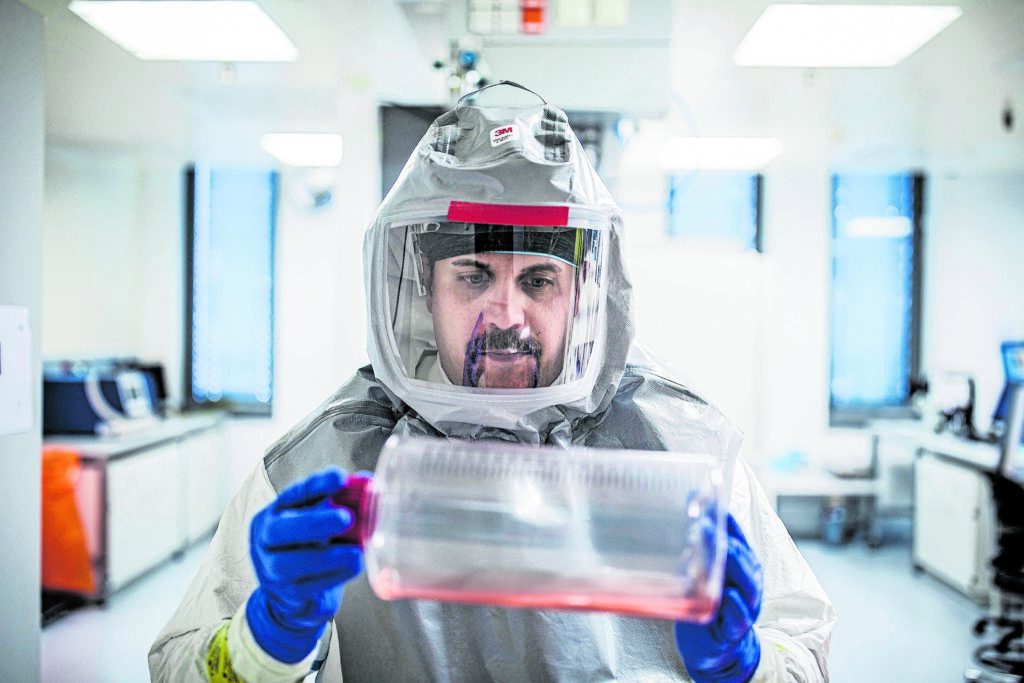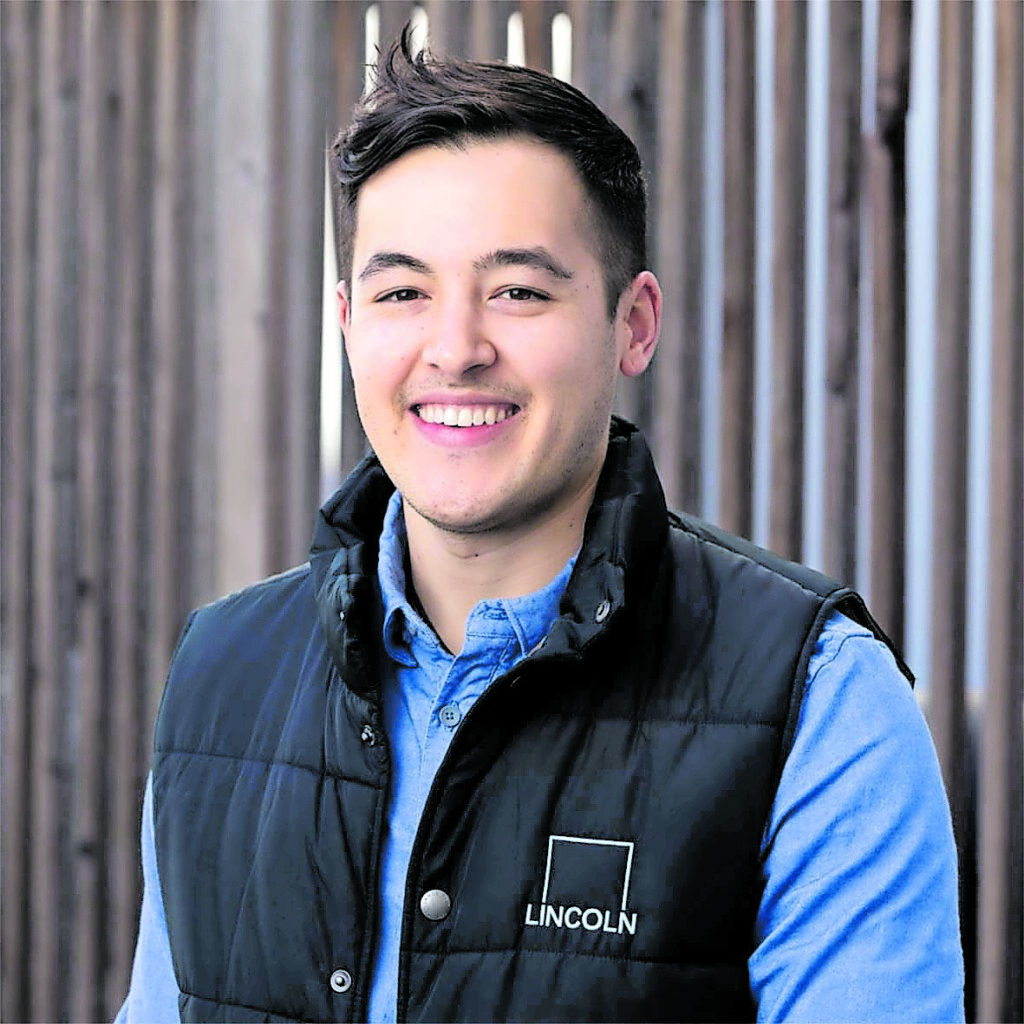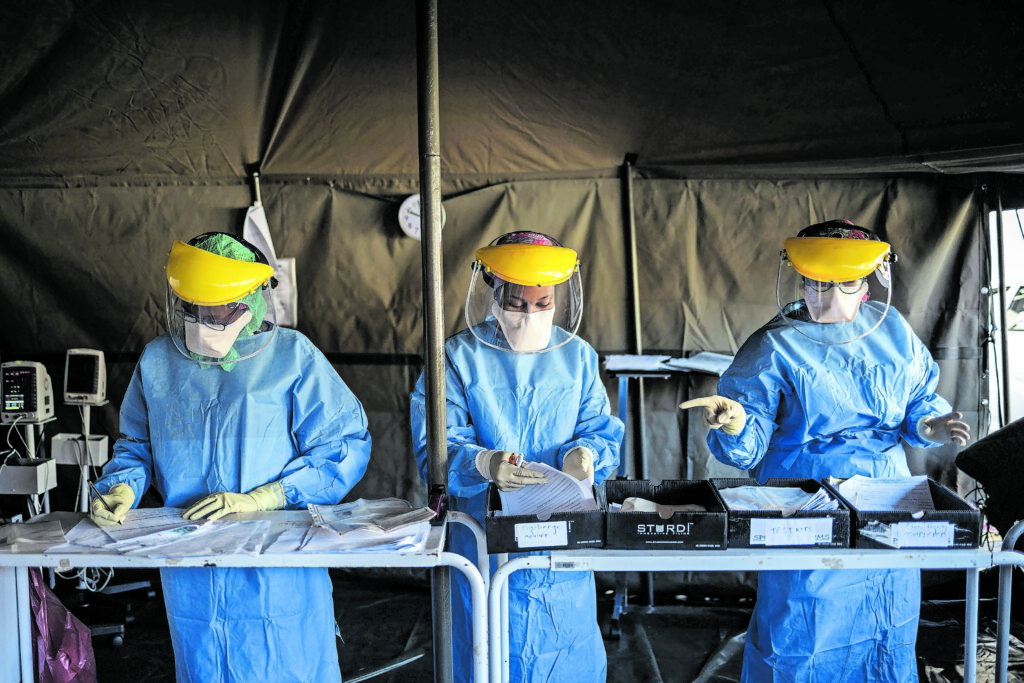A worker of the Xilotepec cemetery in Xochimilco cleans the unloading area before receiving a corpses of Covid-19 victims as the are stored for destruction on May 8, 2020 in Mexico City, Mexico. (Photo by Cristopher Rogel Blanquet/Getty Images)
COMMENT
Hindsight is a strange thing to attempt in a year when so many markers of time are missing — birthdays, weddings, funerals, Easter, Passover, Eid. Even performing rituals online still felt a little like being inside a casino, a room with no clocks and no windows.
Yesterday it was March, now it is December. It is a little over a year since a cluster of patients in Hubei province in China began showing signs of an unusual respiratory disease, which the authorities formally reported in late December 2019 and was identified in January as being caused by a novel coronavirus (2019‑nCoV). At that point, there was no evidence of human-to-human transmission, and the outbreak was linked to one specific seafood market in the capital city of Wuhan.
The first official death attributed to the virus was recorded on 11 January 2020. The day before, a Shanghai public health professor named Yong-Zhen Zhang had managed to publish the genetic sequence of the “coronavirus associated with the Wuhan outbreak” on an open-access virology website.
Over the next week the very first vaccine prototypes were designed using the same sequence. At least one of these, the vaccine developed by Moderna, has since reported an efficacy of over 94% following clinical trials. In November the company announced it would produce up to 20-million doses of the vaccine before the end of this year, with as many as 500-million to a billion doses in 2021.
Some of you may die, but it’s a sacrifice I am willing to make
Lord Maximus Farquaad
To date not just one but three vaccines have so far shown to be effective against what was subsequently renamed as the severe acute respiratory syndrome coronavirus 2, (Sars‑CoV-2), causing coronavirus disease 2019 or Covid-19. Before Covid-19, the fastest a major vaccine had ever been developed was for mumps, and that took four years (although this was back in the 1960s). This time it had taken 10 months.
In the Hollywood movie this would be the triumphant finale. The part where refrigerated trucks and scientists wearing hazmat suits flick their needles to a sombre but hopeful musical score, and drones fly over Africa and air-drop vaccines like Leon Schuster once did with a Coca-Cola bottle.
Except right now there are no Hollywood movies (or if there are, they’re coming to you on Netflix or HBO). And this isn’t a Hallmark moment. Yet.
As I write, nearly 230 000 new infections and more than 2 700 deaths have been reported in the United States in a 24-hour period. India reported 36 000 new cases and more than 500 new deaths in one day. In South Africa more people have officially died from Covid-19 than are murdered each year, and our second waves are only beginning.
 A lab technician wearing a full body protection suit inspects a bottle containing growth media for virus production during coronavirus vaccine research at the Valneva SA laboratories in Vienna, Austria. (Photo: Akos Stiller/Bloomberg via Getty Images)
A lab technician wearing a full body protection suit inspects a bottle containing growth media for virus production during coronavirus vaccine research at the Valneva SA laboratories in Vienna, Austria. (Photo: Akos Stiller/Bloomberg via Getty Images)
People who tell you that this kind of death, this kind of illness, is normal are wrong. Just because there is a precedent for mass loss of life doesn’t make it a benchmark.
In the past year we have learned a lot about the coronavirus that has reshaped our world, but we are also constantly coming up against the limits of this knowledge: what the “known-knowns” are, as well as the “known-unknowns”.
We know which virus causes the disease and, now, which types of vaccines are currently likely to prevent it or at least make it less deadly. We know that indoor spaces pose a higher exposure risk than outdoors but we still don’t know exactly how the virus spreads — is it in aerosols that linger in the air for minutes or even hours, or spread via heavier droplets that fall to nearby surfaces or the ground quickly?
It’s not clear what role surfaces (fomites) play in the spread of the virus. We don’t know why some people become super-spreaders and others don’t seem to pass on the disease at all. Or why some infected people remain asymptomatic while others develop life-threatening complications.
We are able to save more lives once infected people get hospitalised, but we’re not entirely sure why some treatments work and others don’t. We don’t know why some people develop what is called Long Covid, or even how to clearly define the chronic symptoms that persist in many sufferers for months after the illness.
We don’t know what kind of protective effect a previous infection has or whether a recovered person will be immune to reinfection, and if so for how long.
It’s important to recognise that we have learned a lot since March, since our first lockdown regulations were devised based on limited knowledge of a new and deadly disease. It’s important to accept that, as we learn more about this disease, protocols and precautions change and are updated.
And it’s important to be transparent about the limits of what we still don’t know, while also not letting “not knowing” become an excuse for not taking precautions.
Epidemiology’s black boxes
We will most likely never know exactly who Patient Zero was, or where or when the Sars-CoV-2 pathogen crossed over from animals to humans. Early speculation blamed the seafood market, then snakes, bats, and even pangolins. Tin-foil hatters claimed it was created in a laboratory.
One of the first prominent disinformation sorties was an 84-minute revenge fantasy posing as a documentary called Plandemic in which a discredited scientist argued that the new coronavirus was man-made, and the pandemic was part of a conspiracy to control the human race through fear. Millions watched the video, including in South Africa where it was shared across social media with an urgent instruction to watch “ASAP before it is taken down”. The video was quickly and widely debunked but the falsehoods stuck to some people like blackjacks, spreading seeds of mistrust.
This — the erosion of trust, not the pursuit of truth — was the primary agenda of the growing amount of pandemic disinformation that began to be shared, that exploited the gaps between what we knew and what we could not know, and exploited our relatively limited experience with things like graphs and exponential growth.
Mixed public health messaging didn’t make it any easier, sometimes even adding to the uncertainty: were masks good or bad? What kinds of masks?
Even the publication of new studies — many issued as pre-prints, meaning before they had undergone peer review — often muddied the issue: was it safe to let children back at school? We knew children seemed to be less affected, but what role did they play in spreading the disease to older generations?
It’s not unusual for there to be black box problems in epidemiology — the gap between what we see happening, and being able to understand exactly why these things happen. Historically we learned about disease from inference and observation, often with flawed results (this was particularly true before European scientists widely adopted the germ theory of disease).
What we don’t often acknowledge is how persistent the misleading narratives created by these errors can be. (Did you know that rats were not responsible for spreading the Black Death across medieval Europe? It was more likely spread via human parasites: fleas and body lice). And how these same narratives can be easily twisted into the belief that the “knowers” know nothing.
Once you can get your audiences to doubt the state about one thing, it’s much easier to make them doubt everything about the state
Thabo Mbeki’s Aids denialism was a foreshadowing of this 20 years ago. Not only did the president and his health minister corrupt the narrative around HIV and Aids, they actively sought to discredit medicine and scientists, blocking the rollout of antiretrovirals while simultaneously promoting their own alternative experts and their fraudulent treatments.
Similar denials, distortions and unchecked egos have played out during 2020, except this time the false messages spread faster (thanks, social media), accompanied by a seemingly endless series of graphs and charts.
Hacking the axes
Instead of months and seasons we counted out 2020 in tests conducted, new cases reported, percentage testing positive, deaths reported, excess deaths, IFRs and CFRs (infection fatality ratio and case fatality ratio, respectively), doubling rates.
We have also consistently tended to overestimate our own competence with either representing or interpreting both the categories of data and the numbers themselves. Between March and April, hundreds of journalists, lawyers, technology gurus and others turned their hands to playing the coronavirus numbers game with frequently poor results.
 Deceptive data: Aaron Ginn used
data from various sources to try
and argue that the health risks of
the pandemic were overstated
Deceptive data: Aaron Ginn used
data from various sources to try
and argue that the health risks of
the pandemic were overstatedOne of these, a Medium post by a Silicon Valley “growth hacker” named Aaron Ginn, used data from Johns Hopkins University and other sources to try and argue that the health risks of the pandemic were overstated, and that risk mitigation strategies such as social distancing would hurt the economy.
Ginn’s work became the subject of a brutal 32-point takedown by biology professor, scientist and Calling Bullshit co-author Carl T Bergstrom, and was considered so flawed that it was removed by Medium for violating the platform’s policies. Still, some people called the removal a form of censorship.
At around the same time in South Africa, a civilian lobby group calling itself Pandata began to put forward similar claims in the local press, where its anti-government number crunching was welcomed rather than critiqued.
On 5 May the Financial Mail quoted the group as saying that the then six-week-old lockdown would result in 29 times more deaths (worked out in “years lost”) than Covid-19 itself. The group also stated that, based on its calculations, it seemed “unlikely that more than a million will die worldwide.”
Two weeks later, on another platform, the faction wrote it was “left wondering why anybody in their right minds would be talking up a story that involves anything more than 10 000 deaths for South Africa.”
(Should you at this point be wondering, global Covid-19 deaths are currently estimated at more than 1.6-million people; South Africa has had more than 23 000 official deaths — unofficial tallies, using excess mortality data, suggest that this figure is much higher. Pandata subsequently, quietly, updated its local estimates.)
Despite its claims being repeatedly disproven, and despite having little credibility among the majority of professional and institutional experts in relevant fields in South Africa, Pandata — and indeed other anti-lockdown “rationalisers” — inexplicably continued to be given frequent and prominent column space and airtime by multiple media outlets.
The crux of the group’s popularity was, at its core, the unpopularity of the national lockdown, particularly in certain suburban enclaves and, it seems, among certain editors.
But it was compounded by weaknesses in the government’s own behaviours — something repeated in many other countries, where a lack of transparency about data combined with often confusing policies made official sources appear less than trustworthy.
This is a key reason why misinformation about the pandemic was so enthusiastically adopted by “alt media” platforms and pundits: once you can get your audiences to doubt the state about one thing, it’s much easier to make them doubt everything about the state.
There were, of course, many private initiatives that were less self-serving — Dr Vukosi Marivate, chair of the University of Pretoria’s data science department, the Media Hack Collective and the Bhekisisa Centre for Health Journalism each put together dashboards that show Covid-19 data. A maths teacher named Sugan Naidoo compiles tables (using national and provincial data) to show active cases, deaths, and hospitalisations. Mathematician Dr Ridhwaan Suliman graphs daily testing numbers and positivity rates.
 Testing times: In South Africa there were a few volunteers who created dashboards using daily testing numbers and positivity rates captured by
health workers (above) to help ordinary citizens make sense of the dizzying Covid-19 data. Photo: Michele Spatari/AFP
Testing times: In South Africa there were a few volunteers who created dashboards using daily testing numbers and positivity rates captured by
health workers (above) to help ordinary citizens make sense of the dizzying Covid-19 data. Photo: Michele Spatari/AFP
These efforts have helped many of us to make a little more sense out of a landscape that governments and statisticians have struggled to make accessible. But, as Max Roser from the Oxford University-hosted information platform Our World in Data has said, this shouldn’t have had to have been the work of volunteers.
The knowledge gap
Anti-lockdown lobbyists have shaped this gap into an expedient dichotomy, one where they are positioned as independent truthers, champions of personal freedom and liberty, while on the other side are corrupt authorities who use lockdowns to deliberately manifest humanitarian crises so that they can take more control.
This entirely misses the point that there is a deadly pandemic, which is still ongoing. And also that every single authority that imposes a lockdown already knows it’s a disaster. But it also knows that the alternatives are even worse.
Lockdowns have worked to save lives. And they have also come at a terrible cost. But without interventions, millions more people would have and will still sicken and die from Covid-19.
The truth is that the anti-lockdowners are pretty much all right with that. The so-called Great Barrington Declaration that many of them support makes this explicit in its goal of reaching “compassionate” herd immunity. Or, to quote Lord Maximus Farquaad from the movie Shrek: “Some of you may die, but it’s a sacrifice I am willing to make.”
In order to publicly justify their increasingly immoderate positions, Covid deniers and lockdown dissenters have had to lie about or distort mortality data so that they don’t appear to be monsters — what I call the Trump cascade principle, where, in order to make one lie seem plausible, you have to support it with a whole bunch of other lies. (Since February this year, by the way, the outgoing American president has said that Covid-19 was “disappearing” at least 40 times ).
Counting the dead
Shortly after the peak of South Africa’s first wave of deaths, misinformation groups sought to undermine the integrity of the country’s excess death data. This information (deaths recorded on the National Population Register and provided to the South African Medical Research Council) is collected separately from the Covid-19 surveillance system that records deaths due to confirmed cases of the virus, and currently indicates more than 52 000 excess deaths for the year so far. The patterns of the excess deaths closely mirror those of infection peaks (with a short lag) and of reported Covid-19 deaths, and it is highly likely they are directly related.
A subset of this debate — similar false claims were made in other countries — revolved around a conspiracy that doctors were overreporting Covid-19 deaths, or obscuring patients’ “real” causes of death.
 Home soil: An aerial shot of freshly dug graves at a Johannesburg cemetery. More people have died of Covid-19 in South Africa than were murdered this year. Photo: Marco Longari/AFP
Home soil: An aerial shot of freshly dug graves at a Johannesburg cemetery. More people have died of Covid-19 in South Africa than were murdered this year. Photo: Marco Longari/AFP
In the United Kingdom, this was alleged to be part of an incentive scheme where physicians supposedly earned extra money for writing Covid-19 on patients’ death certificates. A similar baseless claim was repeated by Trump in America just days before he lost the election.
These fabrications relied on a lack of public knowledge about the death reporting process, in South Africa and other countries (the short version is: it doesn’t happen like in the movies).
They were also enabled by not so much knowledge gaps but rather bureaucratic gaps, such as lags in death reporting times and differences between how regions reported Covid-19 deaths.
One example of this is Sweden — the “no lockdown” model frequently preferred by anti-lockdowners, despite its subsequent high first-wave death rate and, now, growing second wave of deaths — where the government presents death information based on the date of the death rather than the date on which the death is reported (for example, a person might die on a Monday but the paperwork might only be submitted on a Friday, or even longer in some countries or contexts).
This meant that while Sweden might report 10 deaths on a Monday, by the time all death reports for that day were submitted, the death count for the day could retrospectively increase to 20.
South Africa’s health department reports deaths the other way around, so there might be 160 deaths reported on a day, but not all of those deaths happened on that day.
When the department briefly changed the way it reported daily death figures, between mid-October and late November, adding a category to indicate the number of deaths reported in the previous 24-48 hours, this was latched on to by Covid-minimisers.
They attempted to claim, for example, that because only five (out of 60-odd) deaths had been reported in the previous day, only five deaths had occurred on that day (conveniently ignoring that the balance of deaths, logically, had to come from other days older than 48 hours — and so on).
This kind of misinformation doesn’t just rely on a lack of familiarity with death reports, it exploits and even cultivates a sort of number numbness, where very large and even very small numbers can seem meaningless, become abstract — like claims that we shouldn’t worry about the new coronavirus because 99.9% of people won’t die from it.
Except: we don’t reliably know a crude mortality rate (the number of people that will die in a population) for Covid-19, and we don’t actually calculate disease fatality rates this way — for good reason.
Even data about case fatality rates (that is, the number of confirmed deaths divided by the number of confirmed cases) can change with different contexts, for example, which country a person lives in and whether they do or don’t have access to medical care.
And this doesn’t take into account the large number of infections that are never officially confirmed as cases (hence “infection fatality rate”). Our World In Data offers an excellent explainer on the differences between crude, case and infection fatality rates.
It’s also rather loathsome to suggest we should somehow be okay with 0.1% of the world dying off, as if Covid-19 was a natural cull. In South Africa more than 21 000 people are murdered every year. This represents a little under 0.04% of the country’s population.
Imagine suggesting we should simply write off these deaths, or stop trying to prevent them?
Social-engineering bias
Cognitive biases are nurture-related faults in our ways of thinking — they are the sum of our individual parts, often invisible but also so hardwired into our thought processes that they can affect how we see with our very own eyes.
Bias is what makes people have trouble recognising the faces of other racial groups, or what makes a man look up in an aircraft and see a sealed air vent even when it is clearly labelled as a light.
Cognitive bias can make people read statistical data wrong, and short-circuit other corrective cognitive processes so that they remain convinced they are right.
These pathways are well-known, and were well-worn long before the pandemic. But Covid-19 itself has had a striking effect on the misinformation landscape.
The methods used to disseminate distrust during the first year of this pandemic are essentially variations on approaches that have been used in the past, to sow confusion around climate change, or vaccines, or even globalisation.
There is not necessarily a single or coherent endpoint to these tactics, they simply jump on whatever topic is expedient (it helps when it is something people feel very strongly about because emotion increases engagement) and then, like a parasite, use the host to build narrative nodes of “alternative truths” which, when read as a whole, are not really in pursuit of truth at all but rather to dispel any notion that “truth” exists.
The Covid-19 infodemic was simply a series of staging points in what, by now, is clearly understood to be a much longer disinformation war.
The deniers’ and rationalists’ Covid stories fall apart. Sweden did not achieve herd immunity; the increase of cases across Europe in late summer was not a “casedemic” (the allegation that the growth in cases was only because of an increase in testing) but an early indicator of the deaths that were to follow; the pandemic did not suddenly end after American elections. As the deniers’ and rationalists’ Covid stories have fallen apart, their world narratives have become increasingly frayed.
This has galvanised an alignment with other “dissident” points of view that they may have considered fringe before the pandemic. People invested in the “herd immunity” strategy find themselves suddenly supporting anti-vaccination lobbies.
Many anti-lockdowners are touting opposition to something called the “great reset” — ostensibly a generic campaign driven by the World Economic Forum to make the world a better, fairer and more sustainable place, but reimagined by conspiracists as a left-wing plot to force people to get vaccinated and stop owning private property. Even this is simply a new cusp of an older arc — it’s easy to spot, because it frequently involves blaming George Soros.
What has happened, essentially, is that Covid-19 has radicalised these people. There’s now a broader spiral of intersecting Venn diagrams that include right-wingers, pro-gun lobbies, people who sell vitamin supplements online, 5G conspiracy theorists and more, all of whom are brought together by their shared spread of misinformation about Covid-19.
It’s a circus of disinformation. And what this means is that, in the coming year, despite and even because of the planned rollout of mass vaccination programmes, the information war is going to become more pitched than ever.